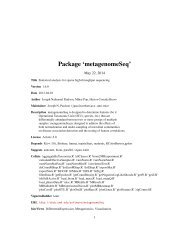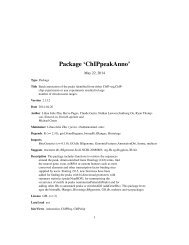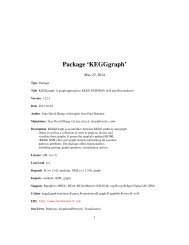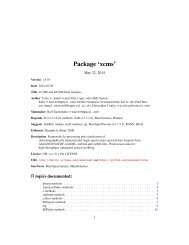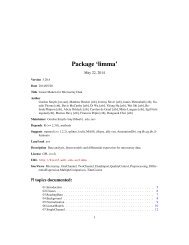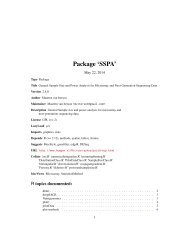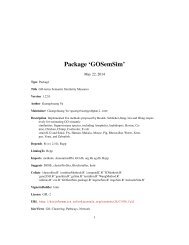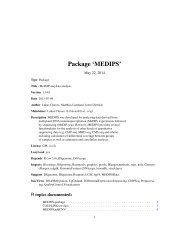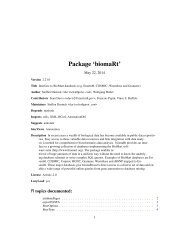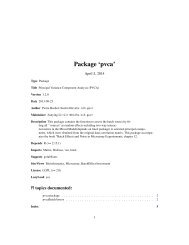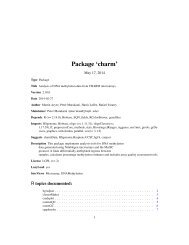Package 'pathview' - Bioconductor
Package 'pathview' - Bioconductor
Package 'pathview' - Bioconductor
You also want an ePaper? Increase the reach of your titles
YUMPU automatically turns print PDFs into web optimized ePapers that Google loves.
pathview 21gene.annotpkgmin.nnodeskegg.nativemap.nullexpand.nodesplit.groupmap.symbolmap.cpdnamenode.sumdiscretelimitmodel organisms. For other species, gene.idtype should be set to "KEGG" asKEGG use other types of gene IDs. For the common model organisms (to checkthe list, do: data(bods); bods), you may also specify other types of valid IDs.To check the ID list, do: data(gene.idtype.list); gene.idtype.list.character, the name of the annotation package to use for mapping between othergene ID types including symbols and Entrez gene ID. Default gene.annotpkg=NULL.integer, minimal number of nodes of type "gene","enzyme", "compound" or "ortholog"for a pathway to be considered. Default min.nnodes=3.logical, whether to render pathway graph as native KEGG graph (.png) or usinggraphviz layout engine (.pdf). Default kegg.native=TRUE.logical, whether to map the NULL gene.data or cpd.data to pathway. WhenNULL data are mapped, the gene or compound nodes in the pathway will berendered as actually mapped nodes, except with NA-valued color. When NULLdata are not mapped, the nodes are rendered as unmapped nodes. This argumentmainly affects native KEGG graph view, i.e. when kegg.native=TRUE. Defaultmap.null=TRUE.logical, whether the multiple-gene nodes are expanded into single-gene nodes.Each expanded single-gene nodes inherits all edges from the original multiplegenenode. This option only affects graphviz graph view, i.e. when kegg.native=FALSE.This option is not effective for most metabolic pathways where it conflits withconverting reactions to edges. Default expand.node=FLASE.logical, whether split node groups are split to individual nodes. Each split membernodes inherits all edges from the node group. This option only affectsgraphviz graph view, i.e. when kegg.native=FALSE. This option also effectsmost metabolic pathways even without group nodes defined orginally. For thesepathways, genes involved in the same reaction are grouped automatically whenconverting reactions to edges unless split.group=TRUE. d split.group=FLASE.logical, whether map gene IDs to symbols for gene node labels or use the graphicname from the KGML file. This option is only effective for kegg.native=FALSEor same.layer=FALSE when kegg.native=TRUE. For same.layer=TRUE whenkegg.native=TRUE, the native KEGG labels will be kept. Default map.symbol=TRUE.logical, whether map compound IDs to formal names for compound node labelsor use the graphic name from the KGML file (KEGG compound accessions).This option is only effective for kegg.native=FALSE. When kegg.native=TRUE,the native KEGG labels will be kept. Default map.cpdname=TRUE.character, the method name to calculate node summary given that multiple genesor compounds are mapped to it. Poential options include "sum","mean", "median","max", "max.abs" and "random". Default node.sum="sum".a list of two logical elements with "gene" and "cpd" as the names. This argumenttells whether gene.data or cpd.data should be treated as discrete. Defaultdsicrete=list(gene=FALSE, cpd=FALSE), i.e. both data should be treated ascontinuous.a list of two numeric elements with "gene" and "cpd" as the names. This argumentspecifies the limit values for gene.data and cpd.data when convertingthem to pseudo colors. Each element of the list could be of length 1 or 2.



